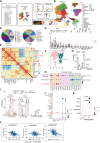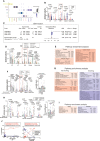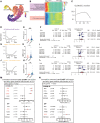Single cell meta-analysis of EndMT and EMT state in COVID-19
- PMID: 36248845
- PMCID: PMC9558222
- DOI: 10.3389/fimmu.2022.976512
Single cell meta-analysis of EndMT and EMT state in COVID-19
Abstract
COVID-19 prognoses suggests that a proportion of patients develop fibrosis, but there is no evidence to indicate whether patients have progression of mesenchymal transition (MT) in the lungs. The role of MT during the COVID-19 pandemic remains poorly understood. Using single-cell RNA sequencing, we profiled the transcriptomes of cells from the lungs of healthy individuals (n = 45), COVID-19 patients (n = 58), and idiopathic pulmonary fibrosis (IPF) patients (n = 64) human lungs to map the entire MT change. This analysis enabled us to map all high-resolution matrix-producing cells and identify distinct subpopulations of endothelial cells (ECs) and epithelial cells as the primary cellular sources of MT clusters during COVID-19. For the first time, we have identied early and late subgroups of endothelial mesenchymal transition (EndMT) and epithelial-mesenchymal transition (EMT) using analysis of public databases for single-cell sequencing. We assessed epithelial subgroups by age, smoking status, and gender, and the data suggest that the proportional changes in EMT in COVID-19 are statistically significant. Further enumeration of early and late EMT suggests a correlation between invasive genes and COVID-19. Finally, EndMT is upregulated in COVID-19 patients and enriched for more inflammatory cytokines. Further, by classifying EndMT as early or late stages, we found that early EndMT was positively correlated with entry factors but this was not true for late EndMT. Exploring the MT state of may help to mitigate the fibrosis impact of SARS-CoV-2 infection.
Keywords: COVID-19; endothelial cells (ECs); endothelial-mesenchymal transition (EndMT); epithelial-mesenchymal transition (EMT); single cell RNA sequencing.
Copyright © 2022 Zhang, Tang, Zhang, Tong, Xie, Yan, Wang, Zhang, Liu and Li.
Conflict of interest statement
Author MZ is employed by the Oncology Bussiness Department, Novogene Co., Ltd, Beijing, China. The remaining authors declare that the research was conducted in the absence of any commercial or financial relationships that could be construed as a potential conflict of interest.
Figures





Similar articles
-
The role of epithelial-mesenchymal transition in pulmonary fibrosis: lessons from idiopathic pulmonary fibrosis and COVID-19.Cell Commun Signal. 2024 Nov 13;22(1):542. doi: 10.1186/s12964-024-01925-y. Cell Commun Signal. 2024. PMID: 39538298 Free PMC article. Review.
-
EMT and EndMT: Emerging Roles in Age-Related Macular Degeneration.Int J Mol Sci. 2020 Jun 16;21(12):4271. doi: 10.3390/ijms21124271. Int J Mol Sci. 2020. PMID: 32560057 Free PMC article. Review.
-
Epithelial to Mesenchymal Transition (EMT) and Endothelial to Mesenchymal Transition (EndMT): Role and Implications in Kidney Fibrosis.Results Probl Cell Differ. 2017;60:345-372. doi: 10.1007/978-3-319-51436-9_13. Results Probl Cell Differ. 2017. PMID: 28409352 Review.
-
Endothelial Cell Senescence Exacerbates Pulmonary Fibrosis Potentially Through Accelerated Endothelial to Mesenchymal Transition.Kobe J Med Sci. 2021 Nov 2;67(3):E84-E91. Kobe J Med Sci. 2021. PMID: 35367994 Free PMC article.
-
Endothelial-specific Loss of IFT88 Promotes Endothelial-to-Mesenchymal Transition and Exacerbates Bleomycin-induced Pulmonary Fibrosis.Sci Rep. 2020 Mar 11;10(1):4466. doi: 10.1038/s41598-020-61292-9. Sci Rep. 2020. PMID: 32161282 Free PMC article.
Cited by
-
Molecular mechanisms of COVID-19-induced pulmonary fibrosis and epithelial-mesenchymal transition.Front Pharmacol. 2023 Aug 3;14:1218059. doi: 10.3389/fphar.2023.1218059. eCollection 2023. Front Pharmacol. 2023. PMID: 37601070 Free PMC article. Review.
-
The role of epithelial-mesenchymal transition in pulmonary fibrosis: lessons from idiopathic pulmonary fibrosis and COVID-19.Cell Commun Signal. 2024 Nov 13;22(1):542. doi: 10.1186/s12964-024-01925-y. Cell Commun Signal. 2024. PMID: 39538298 Free PMC article. Review.
-
Single-cell 'omic profiles of human aortic endothelial cells in vitro and human atherosclerotic lesions ex vivo reveal heterogeneity of endothelial subtype and response to activating perturbations.Elife. 2024 Apr 5;12:RP91729. doi: 10.7554/eLife.91729. Elife. 2024. PMID: 38578680 Free PMC article.
-
Diverse roles of SARS-CoV-2 Spike and Nucleocapsid proteins in EndMT stimulation through the TGF-β-MRTF axis inhibited by aspirin.Cell Commun Signal. 2024 May 28;22(1):296. doi: 10.1186/s12964-024-01665-z. Cell Commun Signal. 2024. PMID: 38807115 Free PMC article.
-
COVID-19-The Shift of Homeostasis into Oncopathology or Chronic Fibrosis in Terms of Female Reproductive System Involvement.Int J Mol Sci. 2023 May 11;24(10):8579. doi: 10.3390/ijms24108579. Int J Mol Sci. 2023. PMID: 37239926 Free PMC article. Review.
References
-
- Kim KK, Kugler MC, Wolters PJ, Robillard L, Galvez MG, Brumwell AN, et al. . Alveolar epithelial cell mesenchymal transition develops in vivo during pulmonary fibrosis and is regulated by the extracellular matrix. Proc Natl Acad Sci United States America (2006) 103(35):13180–5. doi: 10.1073/pnas.0605669103 - DOI - PMC - PubMed
-
- Willis BC, Liebler JM, Luby-Phelps K, Nicholson AG, Crandall ED, Du Bois RM, et al. . Induction of epithelial-mesenchymal transition in alveolar epithelial cells by transforming growth factor-B1: Potential role in idiopathic pulmonary fibrosis. Am J Pathol (2005) 166(5):1321–32. doi: 10.1016/S0002-9440(10)62351-6 - DOI - PMC - PubMed
Publication types
MeSH terms
Substances
LinkOut - more resources
Full Text Sources
Medical
Miscellaneous

